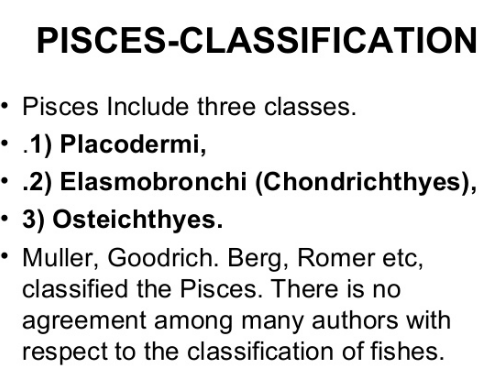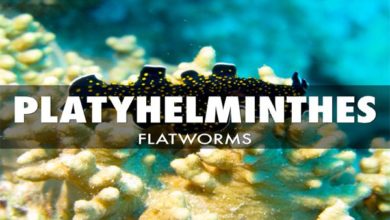Pisces Sub-Classes: Characteristics, Examples and Economic Importance
In this post, you are going to learn about the Pisces Examples and Explanation step by step with Diagram.
- economic importance of Pisces
- characteristics of class Pisces
- features of Pisces in biology
- adaptive features of Pisces
- Lots more
So if you want to get benefits from this post you’ll love this post.
Let’s Dive right in..
Super-class Pisces is divided into three classes:
- Cyclostomata.
- Chondrichthyes.
- Osteichthyes.
1. Class Cyclostomata
It includes most primitive living vertebrates. They are without jaws. Their examples are lampreys and hagfish. They show the following characteristics:
- The body is long eel-like.
- Scales are absent.
- No paired appendages (jointed parts, i.e. fins).
- Cartilaginous skeleton.
- Ventral suctorial mouth.
- Heart with one auricle.
- Six to fourteen pairs of gills.
- The stomach is absent in the digestive system.
- Sexes are separate in lampreys. Hag fishes are hermaphrodite.
- Fertilization is external. There is a long larval period in Lamprey.
2. Class Chondrichthyes
This group includes sharks and rays. They have a cartilaginous skeleton. But they show many resemblances with the bony fishes. The cartilaginous skeleton is not a primitive character. It is a degenerative character. Their main features are:
- The body is fusiform.
- Ventral olfactory sacs are not connected to the mouth cavity.
- The body is covered by placoid scales.
- Their endoskeleton is completely cartilaginous.
- Their digestive system has J — shaped stomach.
- The circulatory system has many pairs of aortic arches.
- They have 5 — 7 pairs of gills. These gills are not covered by an operculum.
- They have no swim bladder.
- Sexes are separate.
- They may be oviparous or viviparous.
- Sharks: The sharks are the largest living vertebrates after whales. The length of some sharks is 30 — 50 feet.
- Skate and Rays: These are bottom-dwelling. Their anterior pair of fins or pectoral fins is much enlarged. They are used for swimming like wings. There are two interesting fishes of these groups:
- Sting Rays: It has a long and whip-like tail. It also has sharp spines. These spines cause a very dangerous wound in the victim.
- Electric Rays: Its certain dorsal muscles are modified into the electric organ. This organ produces severe shock and stuns its prey.
Economic Importance of Pisces (Sharks)
- They destroy fish, lobsters, and crabs.
- Sharks are used as food in some parts of the world.
- The oil from the liver of sharks is extracted. This oil has Vitamin A and D. So it is used in medicines.
- The skin of sharks is used for making articles.
3. Class Osteichythes: (Bony fishes)
They show the following characteristics:
- They have an almost a bony skeleton. It has replaced the cartilaginous skeleton.
- A small part of the notochord may persist.
- Dermal scales are embedded in the skin. These scaled may be ganoid, cycloid or ctenoid. Placoid scales are absent in them.
- They have both unpaired (median) and paired fins. These fins have cartilaginous or bony fin rays
- The mouth is terminal. Teeth may or may not present on the jaws.
- Respiration takes place by gills. These gills are supported by gill arches. Gills are covered by an operculum.
- A swim bladder is usually present. It may or may not have a connection with the pharynx. It helps in buoyancy.
- Their heart has two chambers, one atrium, and one ventricle. Blood has nucleated red blood cells.
- Brain with 10 pairs of cranial nerves.
- Sexes are separate. Gonad (testes or ovary) are present in pairs. Fertilization is usually external.
Adaptations for Aquatic Life (Pisces)
The following are the major adaptations in fishes for the aquatic mod of life.
- Streamlined body (boat-shaped): Streamlined body produces little resistance in water during swimming.
- Swim bladder: Swim’s bladders are found in most of the bony fishes. It may or may not be connected with the pharynx. Swim bladders are hydrostatic organ. Fish can change its gravity by filling gas in the swim bladder. So the fish can float higher or skin lower in water. The swim bladder is filled with gases like oxygen, carbon dioxide, and nitrogen. These gases are secreted by glands, present in the swim bladder. If swim bladder is connected with the pharynx, it is filled by gulping air.
- Fins: These are another important adaptation for aquatic life. Fins are of two types:
- Paired fins: Pectoral and pelvic fins
- Unpaired fins: These are dorsal fin, caudal fin (tail), and anal fin (present near the anus). Fins keep the balance of the fish in the water. So they help in swimming.
- Circulatory system: Their heart has two chambers. It has afferent (which supplies blood to gills) and efferent (it carry away blood from gills) branchial system.
- Respiratory system: In most fishes, the respiratory organs are gills. The gills have a network of capillaries. So gills absorb oxygen dissolved in water. It also removes CO2 in the water.
- Excretory organ: The kidneys of the fish are modified for the excretion in the aquatic environment.
The evolution from Aquatic to Terrestrial Chordates
The vertebrates have already adapted to aquatic life. Dipnoi (lungfishes) is a group of ancient fishes. It has modified its aquatic breathing system. It has developed lungs for terrestrial mod of life. However, this is only a transition stage to land condition.
Modification in Animals for Transition from Aquatic to Land (Pisces)
The following medications take place in animals for facing the terrestrial environment.
- Development of skin for the protection against dry conditions of the land.
- The eggs of the land animals are covered by a shell. It protects embryos from drying and mechanical injury. The egg has a large size for the storage of food.
- The terrestrial animals have replaced the gills by lungs. Lungs take oxygen from the air.
- Certain changes take place in the circulatory system for absorbing oxygen from the lungs.
- The paddle-like fins are replaced by jointed appendages. These appendages are modified for walking, running, climbing, and flying.
- Sensory organs have become more advance and specialized.
The transition from Aquatic to Land Habitat
Amphibians are the borderline between aquatic and true terrestrial animals. Fossil evidence is present form the Devonian period about the evolution of amphibians. This evidences tell that amphibians were evolved from lobe-fin fishes called Dipnoi. These fishes live in shallow freshwater. Some of them crawl from one pool (pond) to the other. So they spent some time on land. It gives rise to amphibians.
Amphibians are the first vertebrates that come on land Amphibians have developed certain terrestrial characters. These characters help them to live on land. On the other hand, amphibians also depend on water. Thus they have retained some aquatic characters. So they lead the double way of life and hence called amphibians (two ways of life). Structurally, they are a transition between fishes and reptiles.
Land Adaptation in Amphibians: Amphibians show following land adaptations. These are:
- They have developed limbs in place of fins.
- They have replaced their gill by lungs.
- Some changes also take place in the skin.
- The circulatory system is modified for lung circulation.
Aquatic character retained by Amphibians: The amphibians retain some aquatic characters in their larval form. These are:
- The larva has gills.
- Circulation of blood and digestive system in larva is of the aquatic mode of life.
The amphibians depend on water during their life history. So they are not a very successful group of vertebrates. They are found only in moist areas or where they can find water.
You May Also Like:



